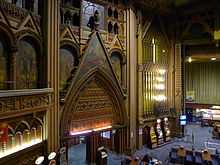Granada, Tooting
| Granada, Tooting | |
|---|---|
 | |
| General information | |
| Architectural style | Art Deco |
| Address | 50-60 Mitcham Road, London, SW17 9NA |
| Coordinates | 51°25′36″N 0°9′59″W / 51.42667°N 0.16639°WCoordinates: 51°25′36″N 0°9′59″W / 51.42667°N 0.16639°W |
| Design and construction | |
| Architect | Cecil Massey |
| Other designers | Theodore Komisarjevsky |
The Granada Cinema in Tooting, an area in the borough of Wandsworth, London was one of the great luxurious cinemas built in the 1930s. It is considered by many to be the most spectacular cinema in Britain.[1]
History
The cinema opened on 7 September 1931, as one of the Granada chain, with the film Monte Carlo and screened movies sometimes with stage shows or organ recitals until it closed as a cinema on 10 November 1973 (showing The Good, the Bad and the Ugly). The organ was a Wurlitzer theatre organ that had originally been used in Sacramento, California. It had a full size stage on which a number of theatrical productions were performed. The normal programme consisted of either two feature films, or one with a variety show.
The building

The building, which became the first cinema to be preserved and given a Grade I listing, was designed by Cecil Massey in the Art Deco style with four Corinthian style pillars over the entrance. It was the interior, however that was (and is still) spectacular. This was designed by Theodore Komisarjevsky, a set designer, making use of ornamental plasterwork by Clark and Fenn. It has marble foyers both at the main and balcony entrances, and a hall of mirrors and deep ceilings more suitable for a palace than a cinema.
The seating capacity was over 3000, and was often completely sold-out. Stars such as Frank Sinatra, Danny Kaye, The Andrews Sisters and Carmen Miranda gave concerts there. After closing as a cinema the building reopened as a bingo hall.
References
- The Granada Theatres, Allen Eyles pp. 42-49 (Cinema Theatre Association, 1998) ISBN 0-85170-680-0
- ↑ "Art Deco buildings in London". Victoria and Albert Museum. Retrieved 18 October 2010.
External links
- Granada Tooting at Scottish Cinemas
- BBC How We Built Britain excerpt covering Granada Tooting
- Granada Tooting at Cinema Treasures